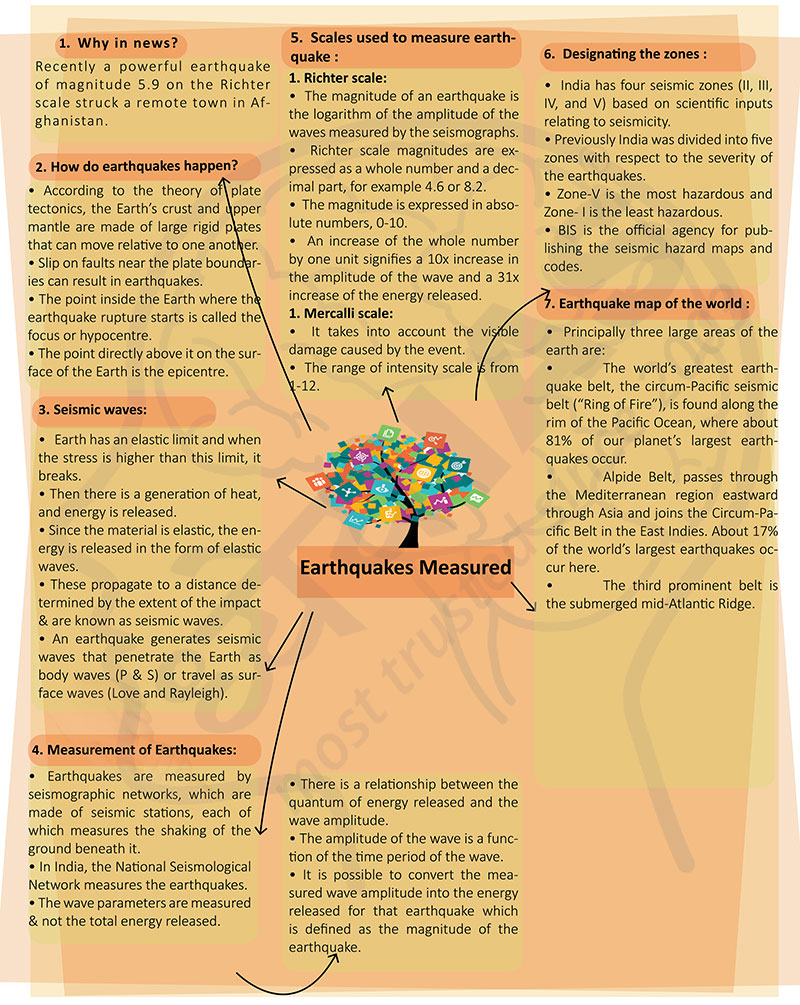Brain-booster
/
04 Aug 2022
Brain Booster for UPSC & State PCS Examination (Topic: Earthquakes Measured)

Why in news?
- Recently a powerful earthquake of magnitude 5.9 on the Richter scale
struck a remote town in Afghanistan.
How do earthquakes happen?
- According to the theory of plate tectonics, the Earth’s crust and upper
mantle are made of large rigid plates that can move relative to one another.
- Slip on faults near the plate boundaries can result in earthquakes.
- The point inside the Earth where the earthquake rupture starts is called
the focus or hypocentre.
- The point directly above it on the surface of the Earth is the
epicentre.
Seismic waves:
- Earth has an elastic limit and when the stress is higher than this
limit, it breaks.
- Then there is a generation of heat, and energy is released.
- Since the material is elastic, the energy is released in the form of
elastic waves.
- These propagate to a distance determined by the extent of the impact &
are known as seismic waves.
- An earthquake generates seismic waves that penetrate the Earth as body
waves (P & S) or travel as surface waves (Love and Rayleigh).
Measurement of Earthquakes:
- Earthquakes are measured by seismographic networks, which are made of
seismic stations, each of which measures the shaking of the ground beneath
it.
- In India, the National Seismological Network measures the earthquakes.
- The wave parameters are measured & not the total energy released.
- There is a relationship between the quantum of energy released and the
wave amplitude.
- The amplitude of the wave is a function of the time period of the wave.
- It is possible to convert the measured wave amplitude into the energy
released for that earthquake which is defined as the magnitude of the
earthquake.
Scales used to measure earthquake:
1. Richter scale:
- The magnitude of an earthquake is the logarithm of the amplitude of the
waves measured by the seismographs.
- Richter scale magnitudes are expressed as a whole number and a decimal
part, for example 4.6 or 8.2.
- The magnitude is expressed in absolute numbers, 0-10.
- An increase of the whole number by one unit signifies a 10x increase in
the amplitude of the wave and a 31x increase of the energy released.
2. Mercalli scale:
- It takes into account the visible damage caused by the event.
- The range of intensity scale is from 1-12.
Designating the zones :
- India has four seismic zones (II, III, IV, and V) based on scientific
inputs relating to seismicity.
- Previously India was divided into five zones with respect to the
severity of the earthquakes.
- Zone-V is the most hazardous and Zone- I is the least hazardous.
- BIS is the official agency for publishing the seismic hazard maps and
codes.
Earthquake map of the world :
- Principally three large areas of the earth are:
- The world’s greatest earthquake belt, the circum-Pacific seismic
belt (“Ring of Fire”), is found along the rim of the Pacific Ocean,
where about 81% of our planet’s largest earthquakes occur.
- Alpide Belt, passes through the Mediterranean region eastward
through Asia and joins the Circum-Pacific Belt in the East Indies. About
17% of the world’s largest earthquakes occur here.
- The third prominent belt is the submerged mid-Atlantic Ridge.







